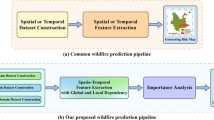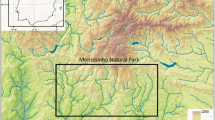Abstract
Wildfire is one of the natural hazards that poses threats to the safety of forest ecological environment. It is very important to predict wildfire risk in the early stage. Most of the wildfire prediction research based on deep learning networks only extracts features on the spatial dimension. In this work, a deep learning model hybridizing 3D CNN and ConvLSTM (Convolutional Long short Term Memory) was proposed, where the strategies of multisource spatiotemporal cooperative feature fusion are adopted. Some redundant wildfire factors with high correlations by multiple collinear analysis and weight analysis were eliminated. Different from other methods, the daily weather forecast was used as the input of the study region, shortening the time prediction resolution from annual or quarterly to daily to achieve a more accurate prediction in time. Taking the daily ignition in Yunnan Province, China, as the research object, the experimental results showed that the proposed model performs well on the test dataset (AUC = 0.901 and accuracy = 0.912). Seven mainstream machine learning methods were employed for comparison with the proposed model. Ablation and comparison experiments show that the proposed model is a valid alternative tool for wildfire susceptibility prediction.











Similar content being viewed by others
Data availability
The datasets generated and/or analyzed during the current study are not publicly available because these data are the results of the author’s efforts and studies but are available from the corresponding author upon reasonable request.
References
Aj A, Ekz B, Mp C, Hs D (2019) Hybrid artificial intelligence models based on a neuro-fuzzy system and metaheuristic optimization algorithms for spatial prediction of wildfire probability. Agricultural and Forest Meteorology s 266–267, 198–207
Bajocco D, Gitas, Smiraglia, Salvati R (2015) Mapping forest fuels through vegetation phenology: the role of coarse-resolution satellite time-series. PLOS ONE
Bashari H, Naghipour AA, Khajeddin SJ, Sangoony H, Tahmasebi P (2016) Risk of fire occurrence in arid and semi-arid ecosystems of iran: an investigation using bayesian belief networks. Environmental Monitoring and Assessment
Bjnes A, Fuente R, Mena P (2021) A deep learning ensemble model for wildfire susceptibility mapping. Ecol Inf 65:101397
Bugallo M, Esteban MD, Marey-Pe´rez MF, Morales D (2023) Wildfire prediction using zero-inflated negative binomial mixed models: application to spain. J Environ Manage 328:116788
Cao Y, Wang M, Liu K (2017) Wildfire susceptibility assessment in southern china:a comparison of multiple methods., 000
Chang Y, Zhu Z, Bu R, Chen H, Wang Z (2013) Predicting fire occurrence patterns with logistic regression in heilongjiang province, china. Landscape Ecol 28:1989–2004
Chen W, Zhou Y, Zhou E, Xiang Z, Lu J (2021) Wildfire risk assessment of transmission-line corridors based on nave bayes network and remote sensing data. Sensors 21:634
Cheng MY, Hoang ND (2015) A swarm-optimized fuzzy instance-based learning approach for predicting slope collapses in mountain roads. Knowl Based Syst 76:256–263
Chongbo W (2019) Methodology and application for wildfire susceptibility assessement based on remote sensing techniques
Dieu TB, Le KT, Van N, Le H, Inge R (2016) Tropical forest fire susceptibility mapping at the cat ba national park area, hai phong city, vietnam, using gis-based kernel logistic regression. Remote Sens 8:347–347
Dimuccio LA, Ferreira R, Cunha L, António, Campar DA (2011) Regional forest-fire susceptibility analysis in central portugal using a probabilistic ratings procedure and artificial neural network weights assignment. Int J Wildland Fire 20:776–791
Eskandari S, Pourghasemi HR, Tiefenbacher JP (2021) Fire susceptibility mapping in the natural areas of iran using new and ensemble data mining models. Environmental Science and Pollution Research, 1–12
George FJ (1977) Optimal data classification for choropleth maps. Occasional paper No. 2. Lawrence, Kansas: University of Kansas, Department of Geography
Hang Z, Zza B, Hong YC, Jca B, Sza B, Xin W, Ys D (2021) The spatial patterns of climate-fire relationships on the mongolian plateau. Agricultural and Forest Meteorology s 308–309
Hantson S, Pueyo S, Chuvieco E (2015) Global fire size distribution is driven by human impact and climate. Glob Ecol Biogeogr 24:77–86
Hochreiter S, Schmidhuber J (1997) Long short-term memory. Neural Comput 9:1735–1780
Iban MC, Sekertekin A (2022) Machine learning based wildfire susceptibility mapping using remotely sensed fire data and gis: a case study of adana and mersin provinces, turkey. Ecological informatics: an international journal on ecoinformatics and computational ecology, 69
Kavlak MO, Cabuk SN, Cetin M (2021) Development of forest fire risk map using geographical information systems and remote sensing capabilities: ren case. Environmental Science and Pollution Research, pp 1–27
Langford Z, Kumar J, Hoffman F (2018) Wildfire mapping in interior alaska using deep neural networks on imbalanced datasets, in: 2018 IEEE International Conference on Data Mining Workshops (ICDMW)
Le HV, Hoang DA, Tran CT, Nguyen QP, Bui DT (2021) A new approach of deep neural computing for spatial prediction of wildfire danger at tropical climate areas. Ecol Inf 63:101300
Liang H, Zhang M, Wang H (2019) A neural network model for wildfire scale prediction using meteorological factors. IEEE Access 7:1–1
Masoud A, Tanvir I, Anil G, Quazi H (2018) An advanced forest fire danger forecasting system: integration of remote sensing and historical sources of ignition data. Remote Sens 10:923
Moritz MA, Parisien MA, Batllori E, Krawchuk MA, Dorn JV, Ganz DJ Hayhoe K (2012) Climate change and disruptions to global fire activity. Ecosphere 3
Oliveira J (2014) Exploring the spatial patterns of fire density in southern europe using geographically weighted regression. Appl Geogr 51
Pham BT, Jaafari A, Avand M, Al-Ansari N, Tuyen TT (2020) Performance evaluation of machine learning methods for forest fire modeling and prediction. Symmetry
Pourtaghi ZS, Pourghasemi HR, Rossi M (2015) Forest fire susceptibility mapping in the minudasht forests, golestan province, iran (vol 73, pg 1515, 2015). Environ Earth Sci
Prapas I, Kondylatos S, Papoutsis I, Camps-Valls G, Ronco M, Fern ́andez-Torres Mn, Guillem P, Carvalhais M, N (2021) Deep learning methods for daily wildfire danger forecasting. arXiv e-prints
Reichstein M, Camps-Valls G, Stevens B, Jung M, Denzler J, Carvalhais N (2019) Prabhat, Deep learning and process understanding for data-driven earth system science. Nature 566, 195
Renard P, Ramesh BR, Kodandapani (2012) Environmental susceptibility model for predicting forest fire occurrence in the western ghats of india. International Journal of Wildland Fire 2012,21(4), 368–379
Rihan Z, Zhang, Guo, Li (2019) Wildfires on the mongolian plateau: identifying drivers and spatial distributions to predict wildfire probability. Remote Sens 11:2361
Sevin V (2023) Mapping the forest fire risk zones using artificial intelligence with risk factors data. Environ Sci Pollut Res 30:4721–4732
Shi X, Chen Z, Wang H, Yeung DY, Wong WK, Woo WC (2015) Convolutional lstm network: a machine learning approach for precipitation nowcasting. MIT Press
Vadrevu KP, Eaturu A, Badarinath K (2010) Fire risk evaluation using multicriteria analysis–a case study. Environ Monit Assess 166:223–239
Xianlin Q (2005) Research on forest fire early warning method combining remote sensing and geographic information system technology
Yathish H, Athira KV, Preethi K, Pruthviraj U, Shetty A (2019) A comparative analysis of forest fire risk zone mapping methods with expert knowledge. Journal of the Indian Society of Remote Sensing
Ying L, Han J, Du Y, Shen Z (2018) Forest fire characteristics in china: spatial patterns and determinants with thresholds. For Ecol Manag 424:345–354
Yu L, Cao Y, Zhou C, Wang Y, Huo Z (2019) Landslide susceptibility mapping combining information gain ratio and support vector machines: a case study from wushan segment in the three gorges reservoir area, china. Appl Sci 9
Zhang G, Wang M, Liu K (2019) Forest fire susceptibility modeling using a convolutional neural network for yunnan province of china. 2019103:386–403
Zhang G, Wang M, Liu K (2021) Deep neural networks for global wildfire susceptibility modelling. Ecol Ind 127:107735
Funding
This work was supported in part by the National NSF of China under Grant 62262062, Grant 61872095, Grant 61571139, Grant 61872128, in part by Fujian Science Fund for Distinguished Young Scholars under Grant 2020J06043, in part by National Key RD Program of China 2021YFB2900900, in part by the Basic Public Welfare Research Plan Project of Zhejiang Province (No. LGG22F010011), and Startup Research Found Plan Project (No. BSYJ202107) funded by Quzhou University, China.
Author information
Authors and Affiliations
Contributions
Jiehang Deng: Conceptualization, Methodology, Supervision. Weiming Wang: Data curation, Writing- Original draft preparation, Validation. Guosheng Gu: Visualization, Investigation. Zhiqiang Chen: Funding acquisition, Writing - review & editing, Investigation. Jing Liu: Software, Data curation. Guobo Xie: Project administration. Shaowei Weng: Investigation. Lei Ding: Resources. Chuan Lie: Formal analysis. All authors read and approved the final manuscript.
Corresponding author
Ethics declarations
Competing interests
The authors declare no competing interests.
Ethics approval
This article does not contain any studies with human participants or animals performed by the author.
Consent to participate
All authors consent to participate this paper.
Consent for publication
All authors consent to publish this paper.
Additional information
Communicated by Hassan Babaie.
Publisher’s Note
Springer Nature remains neutral with regard to jurisdictional claims in published maps and institutional affiliations.
Rights and permissions
Springer Nature or its licensor (e.g. a society or other partner) holds exclusive rights to this article under a publishing agreement with the author(s) or other rightsholder(s); author self-archiving of the accepted manuscript version of this article is solely governed by the terms of such publishing agreement and applicable law.
About this article
Cite this article
Deng, J., Wang, W., Gu, G. et al. Wildfire susceptibility prediction using a multisource and spatiotemporal cooperative approach. Earth Sci Inform 16, 3511–3529 (2023). https://doi.org/10.1007/s12145-023-01104-6
Received:
Accepted:
Published:
Issue Date:
DOI: https://doi.org/10.1007/s12145-023-01104-6




